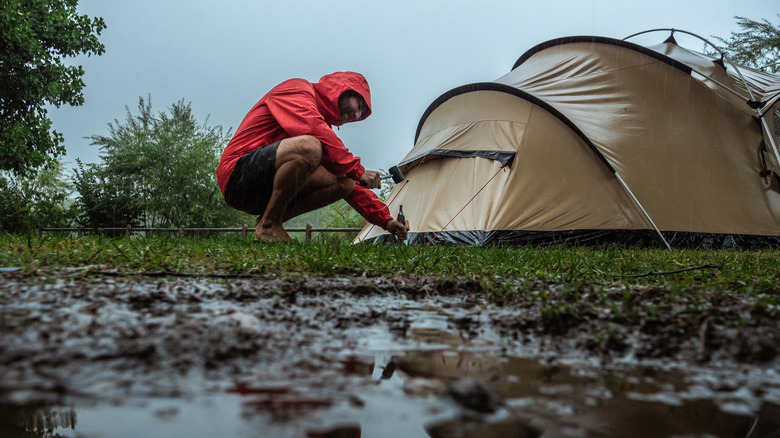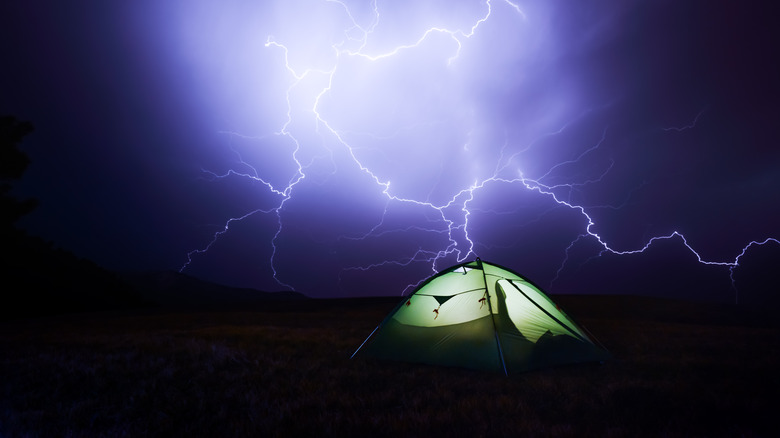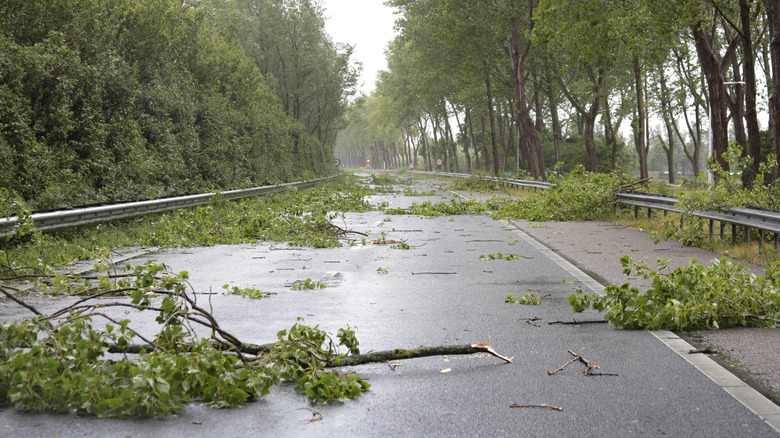What To Do If A Storm Hits During Your Camping Trip
Sometimes, even with the best of intentions and planning, a storm comes in to wreak havoc on your camping trip. There's nothing like watching Mother Nature unleash around your tent to give you a whole new appreciation for the wilderness. To keep you and fellow campers as safe as possible, there are a few measures you can take.
If you're not already doing so, monitor the weather forecast with the Storm Tracker app or a battery-operated weather radio. It's important to note that you're more likely to experience a thunderstorm in the afternoon during the summer months, according to the Centers for Disease Control and Prevention (CDC). Therefore, plan your hikes and water excursions during the earliest part of the day, so you have time to get back to safety if needed.
Pay attention to your surroundings. The signs of an impending storm are wind that picks up suddenly, darkening skies, the smell of rain, the sound of thunder, and lightning flashes, notes the National Weather Service. If you notice any of these signs, pull everything out of your tent and stow it in a shelter or your car and with the windows fully up.
What to do during the storm
Even if the storm isn't right on top of you yet, move to shelter as quickly as possible. Lightning can strike from up to 10 miles away, says the National Oceanic and Atmospheric Administration (NOAA). The best place to be during a storm is far away from your tent. Not only can it blow over and soak your belongings, but the metal rods are a good conductor for lightning. There's also the risk of flooding in low-lying areas near bodies of water.
If you can, head to a nearby shelter with four walls, like the reception area, camp showers, or a nearby store or house. If you're not near a closed shelter, get inside your car. If you are backpacking and your car isn't parked nearby, ditch any metal objects that you're carrying and head downhill away from open fields. A lone tree can act like a lightning rod, so sheltering beneath a group of trees in a low-lying area is better, notes the CDC. It's best to stay away from metal or water-soaked objects that can channel electricity, like barbed wire fences, wet ropes, or tent poles.
What to do after the storm
It's unlikely that, unless you fail to check the weather all together, you'd be caught off guard by days of rain on a camping trip. More than likely you're facing a short weather burst. Even when it seems like the storm has moved through your area, stay put for at least 30 minutes before you get back to your outdoor activities. The most dangerous parts of a storm are the beginning and end, says the CDC.
After enough time has passed, survey the damage at your campsite. Move any soaked objects under a tarp or the awning of a building so they have a chance to dry out. Help other people who may be in need. Report any fallen trees blocking the road or downed power lines to officials, as they could pose a risk to you and other campers. If someone has been struck by lightning, perform CPR and call 911 immediately.
When you decide to leave your campsite, do not attempt to cross flood zones on foot or in your vehicle. All it takes is six inches and a rapid current to knock a person down, says the Federal Emergency Management Agency (FEMA). And, in a car, one foot of fast-moving water can sweep your car away. Instead, navigate to an alternative route, tune into updates from authorities, or wait it out until the flood waters recede. As is always the case with wilderness activities, it's better to be safe than sorry.


